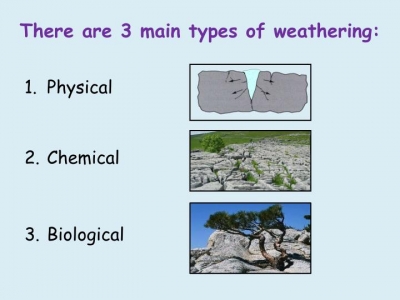
Weathering occurs when rocks are weakened, so that they crack and then break up into smaller pieces. This natural process can be caused by rainfall, changes in temperature or even by plants as they grow. Weathering and erosion constantly change the rocky landscape of Earth. Weathering wears away exposed surfaces over time. The length of exposure often contributes to how vulnerable a rock is to weathering. Rocks, such as lavas, that are quickly buried beneath other rocks are less vulnerable to weathering and erosion than rocks that are exposed to agents such as wind and water.
As it smoothes rough, sharp rock surfaces, weathering is often the first step in the production of soils. Tiny bits of weathered minerals mix with plants, animal remains, fungi, bacteria, and other organisms. A single type of weathered rock often produces infertile soil, while weathered materials from a collection of rocks is richer in mineral diversity and contributes to more fertile soil. Soils types associated with a mixture of weathered rock include glacial till, loess, and alluvial sediments.
Biological Weathering:
This is when plants or animals cause rocks to break up. Plant rocks to break up. Plant roots often grow into small cracks in rocks, splitting them apart. An animal digging can also turn rocks into rubble.
Microscopic organisms like algae, moss, lichens and bacteria can grow on the surface of the rocks and produce chemicals that have the potential of breaking down the outer layer of the rock. They eat away the surface of the rocks. These microscopic organisms also bring about moist chemical micro-environments which encourage the chemical and physical breakdown of the rock surfaces. The amount of biological activity depends upon how much life is in that area. Burrowing animals such as moles, squirrels and rabbits can speed up the development of fissures.
Chemical Weathering:
Chemical reactions can break up rock. Acid rain, for example, destroys the stone in statues and buildings.
The natural chemical reactions within the rocks change the composition of the rocks over time. Because the chemical processes are gradual and ongoing, the mineralogy of rocks changes over time thus making them wear away, dissolve, and disintegrate.
The chemical transformations occur when water and oxygen interacts with minerals within the rocks to create different chemical reactions and compounds through processes such as hydrolysis and oxidation. As a result, in the process of new material formations, pores and fissures are created in the rocks thus enhancing the disintegration forces.
Physical or Mechanical Weathering:
Wind water and temperature changes weaken rock. If water in a crack freezes, it expands and can tear a rock apart. One of the most common mechanical actions is frost shattering. It happens when water enters the pores and cracks of rocks, then freezes. Frost weathering, frost wedging, ice wedging or cryofracturing is the collective name for several processes where ice is present. These processes include frost shattering, frost-wedging and freeze-thaw weathering.
Another type of mechanical weathering is called salt wedging. Winds, water waves, and rain also have an effect on rocks as they are physical forces that wear away rock particles, particularly over long periods of time. These forces are equally categorized under mechanical or physical weathering because they release their pressures on the rocks directly and indirectly which causes the rocks to fracture and disintegrate.
Picture Credit : Google

